Quick Look
Grade Level: 11 (9-12)
Time Required: 1 hours 30 minutes
(two 45-minute periods)
Lesson Dependency: None
Subject Areas: Computer Science, Measurement, Physics, Science and Technology
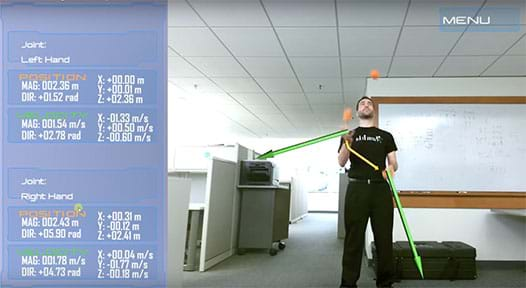
Summary
Students learn about video motion capture technology, becoming familiar with concepts such as vector components, magnitudes and directions, position, velocity, and acceleration. They use a (free) classroom data collection and processing tool—the ARK Mirror—to visualize and record 3-D motion. The Augmented Reality Kinematics (ARK) Mirror software collects data via a motion detector. Using an Orbbec Astra Pro 3D camera or Microsoft Kinect (see note below), students can visualize and record a robust set of data and interpret them using statistical and graphical methods. This lesson introduces students to just one possible application of the ARK Mirror software—in the context of a high school physics class. Note: The ARK Mirror is ported to operate on an Orbbec platform. It may also be used with a Microsoft Kinect, although that Microsoft hardware has been discontinued. Refer to the Using ARK Mirror and Microsoft Kinect attachment for how to use the ARK MIrror software with Microsoft Kinect.Engineering Connection
Like engineers, students apply the concepts of statistical and graphical data interpretation to make sense of a large amount of sensor data. For example, computer scientists and informatics engineers use these concepts to create intelligent computer programs that interpret medical images and optimize medical processes. By using the ARK Mirror to record and interpret motion data, students can apply these concepts to a range of research fields, such as performance optimization in sports kinesiology.
Learning Objectives
After this lesson, students should be able to:
- Define vector, position, velocity, and acceleration.
- Explain how velocity vectors can help us understand common body motions such as jumping, walking or throwing.
- Describe a potential application of the ARK Mirror outside of the classroom.
Educational Standards
Each TeachEngineering lesson or activity is correlated to one or more K-12 science,
technology, engineering or math (STEM) educational standards.
All 100,000+ K-12 STEM standards covered in TeachEngineering are collected, maintained and packaged by the Achievement Standards Network (ASN),
a project of D2L (www.achievementstandards.org).
In the ASN, standards are hierarchically structured: first by source; e.g., by state; within source by type; e.g., science or mathematics;
within type by subtype, then by grade, etc.
Each TeachEngineering lesson or activity is correlated to one or more K-12 science, technology, engineering or math (STEM) educational standards.
All 100,000+ K-12 STEM standards covered in TeachEngineering are collected, maintained and packaged by the Achievement Standards Network (ASN), a project of D2L (www.achievementstandards.org).
In the ASN, standards are hierarchically structured: first by source; e.g., by state; within source by type; e.g., science or mathematics; within type by subtype, then by grade, etc.
NGSS: Next Generation Science Standards - Science
-
Momentum is defined for a particular frame of reference; it is the mass times the velocity of the object.
(Grades 9 - 12)
More Details
Do you agree with this alignment?
International Technology and Engineering Educators Association - Technology
-
Students will develop an understanding of the role of society in the development and use of technology.
(Grades
K -
12)
More Details
Do you agree with this alignment?
-
Students will develop abilities to use and maintain technological products and systems.
(Grades
K -
12)
More Details
Do you agree with this alignment?
State Standards
Tennessee - Science
-
Describe the dynamic interplay among science, technology, and engineering within living, earth-space, and physical systems.
(Grades
9 -
12)
More Details
Do you agree with this alignment?
-
Investigate kinematics and dynamics.
(Grades
9 -
12)
More Details
Do you agree with this alignment?
-
Investigate the relationships among speed, position, time, velocity, and acceleration.
(Grades
9 -
12)
More Details
Do you agree with this alignment?
-
Investigate, measure, and calculate position, displacement, velocity and acceleration.
(Grades
9 -
12)
More Details
Do you agree with this alignment?
-
Demonstrate the relationship between speed and velocity.
(Grades
9 -
12)
More Details
Do you agree with this alignment?
-
Distinguish between speed and velocity.
(Grades
9 -
12)
More Details
Do you agree with this alignment?
Worksheets and Attachments
Visit [www.teachengineering.org/lessons/view/van2-2268-intro-vectors-augmented-reality-kinematics-mirror] to print or download.Pre-Req Knowledge
- An understanding of vectors and scalars.
- Familiarity with basic kinematic quantities (position, velocity, acceleration).
- How to use a graphing program such as Microsoft® Excel® or Vernier Logger Pro.
Introduction/Motivation
Imagine for a minute that you are a scout for a Major League Baseball team. Your task: to compare the performance and style of two different pitchers during spring training. How would you go about evaluating these athletes? (Listen to student ideas.)
We could start by examining their statistics—earned run average, fastball speed or strikeout percentage. But what if we wanted to know why one pitcher is better than another? How does one pitcher move his body in such a way that he throws faster than another?
In baseball lingo, scouts use the term “pitching mechanics” to describe the sequence of movements that enables pitchers to hurl 99 mph fastballs.
Here's another example—the skeletal alignment of a dancer. How does the spine bend during leaps, rolls or spins? How level are the hips during various movements? Sports scientists and kinesiologists, those who study the motion of the human body, use similar motion-tracking technology to collect data on how the body moves.
In today’s lesson, you are going to learn the skills necessary to begin answering these questions to study the motion of your own bodies.
Lesson Background and Concepts for Teachers
Initial note: This lesson is designed to precede the associated activity, Visualizing Body Motion Vectors. It contains information to familiarize students with the ARK Mirror tool and provides detailed instructions so they can use the ARK Mirror creatively and for their own research questions and projects.
Math/Physics Background
The ARK Mirror software package developed at Vanderbilt University can be used for high-level analysis of complex motion or for basic visualization of concepts like vectors and velocity. This free software is designed to be run on a computer using an Orbbec Astra Pro. To understand the practical aspects of ARK Mirror technology, students must gain an understanding of the math and physics concepts for this lesson. Students also familiarize themselves with concepts like vector components, magnitudes and directions, and kinematic quantities like position, velocity, acceleration, and momentum.
In mathematical terms, vectors are objects that have two independent properties: size, or magnitude, and direction. They can be juxtaposed with scalars, which have magnitude but no direction. A vector example is velocity, which is how fast something is going in a particular direction, such as a car traveling 40 km/h (or ~25 mph) going east. An scalar example is temperature. A pot of boiling water has a temperature of 100 ℃ (212 ℉)—but the water isn’t moving in any direction. Direction can be measured in a number of ways. When we travel in a car, we typically say we’re going a certain speed, 40 km/h in a certain direction, northwest. We can also express our vector as an angle measured in degrees or radians counter-clockwise starting from a positive x-axis. Instead of traveling northwest, we could say we are going 40 km/h at 315°, or 3pi/4 radians.
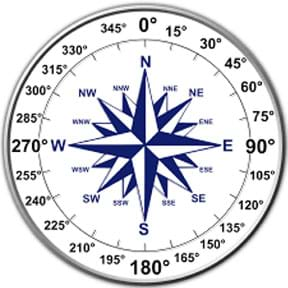
While the magnitude-direction notation can be useful, another way to express vector quantities uses right-angle components that, when added, produce the original vector. Without diving too far into vector addition, a 5-unit-long vector at an angle of 37° would have an x-component of 4 units and a y-component of 3 units (see Figure 1).
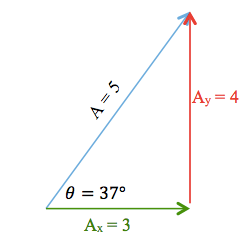
In three dimensions (which is how the ARK Mirror does its measuring), each vector has a third z-component. The motions of each right-angle component do not affect the other component. Instead, they act independently of each other.
In physics, we use the concepts of position, velocity and acceleration to describe the motion of objects:
- Position refers to the location of an object relative to a specific point of reference or origin. It can be expressed as a vector with its tail at the origin and its tip representing where it is heading.
- Velocity is a vector that indicates the rate of change of position over time—unlike speed, velocity has a direction.
- Acceleration is the rate of change of velocity over time.
Position, velocity and acceleration are used together to describe several complex motions in multiple directions. Since each is a vector, they can each be expressed as a whole number with a direction, or as a set of two or three components. An object moving in a circular path, for example, has a velocity that is perpendicular to the radius of that circle—also known as a tangential velocity. The acceleration of that object would be inward, toward the center of the circle--or a centripetal acceleration. For example, think about a probe orbiting our Moon. Its circular path around the moon is its tangential velocity, but its orbit— the gravitationally curved trajectory—is its centripetal acceleration. In physics, we use the term momentum to refer to the product’s mass and its velocity, such as a 100 kg probe moving at 10 m/s. Momentum roughly indicates how much motion an object has in a given direction.
Engineering Background
Current technology in sports science allows analysts and trainers to gather data about a player’s speed, acceleration, as well as the forces of strain on a specific part of a player’s body. Some systems make use of electronic gyroscopes and accelerometers, which can sense the orientation and acceleration of a player or game object, like a baseball. The system then relays the data back to a control center for interpretation. Newer systems are now making use of video motion capture. For example, such technology allows a human user the ability to process a video frame-by-frame. If the user has a reference object in the image for scale, then it is possible to use the location of the object relative to the frame of the image to determine the motion of the object over time. More complex systems use computer algorithms in image processing, which is how the ARK Mirror works. These algorithms affix special markers to a player’s body at particular joints to give a computer a clearer focal point. These systems can be expensive, but are useful in the fields of sports science and kinesiology for tracking an athlete’s motion. The process is also used in other fields such as forensics, ballistics, or construction (for example, a motion-capture of a model bridge during a stress test).
How the ARK Mirror Works
It is important that the teacher has a good grasp of the ARK Mirror capabilities and how to operate it so students can learn to do the same. A description of the structure and features of the program in addition to some of the auxiliary concepts referenced in this lesson is provided below.
The ARK Mirror uses an Orbbec 3D camera, the Astra Pro, which provides computer vision that enables dozens of functions such as face recognition, gesture recognition, human body tracking, three-dimensional measurement, environment perception, and three-dimensional map reconstruction. Orbbec cameras are used in interactive systems, entertainment, retail, robotics, and, of course, education.
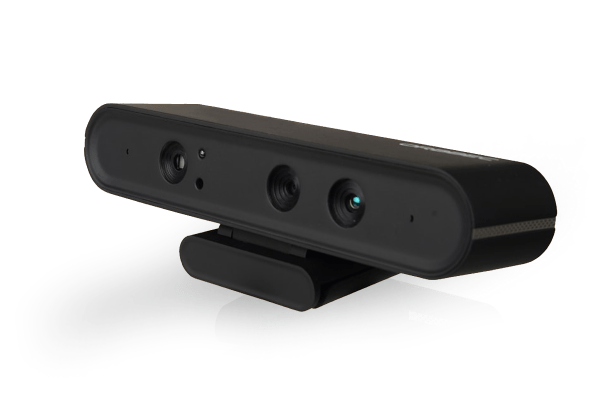
The ARK Mirror harnesses Orbbec technology by receiving sensor data on the position of any desired human body joint. It calculates the velocity and acceleration of this joint based on that position data, and displays these quantities in two ways: as numerical outputs in the form of statistical data and as a visual output, in the form of arrows overlaid on a mirror-image of the user shown on screen. The ARK Mirror also offers users the option to save the data (position, velocity, acceleration, and momentum) to a text file, which can then be brought into Excel or another data processing program for interpretation.
In order to smooth out the raw sensor data, the ARK Mirror has a built-in filtering process that it applies to the incoming data from the Orbbec device. This filter is called a Kalman filter—a predictive algorithm that uses a series of measurements observed over time. By estimating through a small number of data points from a previous scan to guess at where the next point should be, it weighs its own guess against where the sensors are telling it the object actually is. It then takes a weighted average of the two as its final answer. By editing some of the source code, the filter can be adjusted to weigh the sensor data more or less heavily, allowing the Orbbec to be “tuned” for various different applications.
Therefore, when graphing the data supplied by the ARK Mirror, it may be desirable to apply a second filter to the data for the purposes of obtaining a smooth graph that can be more easily interpreted by students. Applying a low-pass filter to cut off high-frequency variations in the data caused by sensor noise may assist with “smoothing” the data. Vernier Logger Pro has a function called “lowPassFilter” that may produce higher quality results.
How to Use the ARK Mirror
Using the ARK Mirror program is simple. For instructions on downloading and installing, please see the Additional Multimedia Support section.
- Once you have successfully connected and set up the Orbbec, open the ARK Mirror program. From the main menu, select “Start.”
- From the secondary menu, select single-joint or double-joint tracking. You have the option to display more data from a single joint, or fewer data for two joints. (For either option, the same amount of data are recorded.)
- You also have the option to record the data to a text file and give a custom name to that file.
- The last option asks you to select whether you would like the motion data recorded in magnitude-angle format or as x-, y-, and z-components. The “Master Sensitivity” slider adjusts the Kalman filter slightly to allow for user preference.
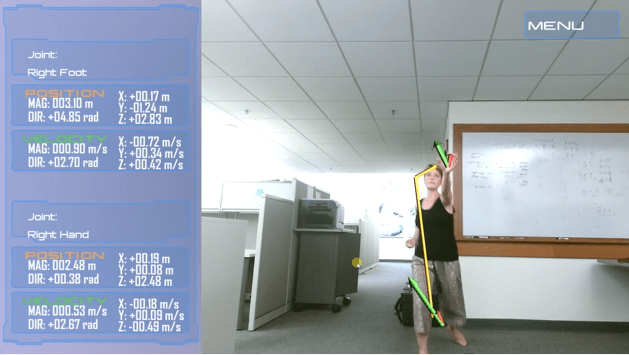
Once you have selected either single- or double-joint tracking, select which joint or joints you want to track by using the associated drop-down menu. You can also designate which kinematic quantities you want to display—position, velocity, acceleration, or momentum. Note that momentum makes use of example mass data for each body joint, and then multiplies the velocity vector by this mass; the double-joint option only tracks two quantities per joint. Once you are satisfied, press “Start.”
Expect to see a visual feed of the user on the right side of the screen, with a sidebar display of data on the left for the selected joints and quantities. Make sure the user's entire body is in the frame. After a few seconds, the user raises his/her right arm to begin being tracked. As soon as the program begins tracking, arrows display over the designated joint and the sidebar display begins updating. Pressing "v’"at any time toggles the velocity arrow on or off, and the same happens with position, acceleration, and momentum by pressing "p," "a," and "m," respectively. If the program stops tracking in any way, the user resets his/her position and raises the right hand again. If another user steps in frame and raises his/her own hand, then that person becomes the tracked user.
Associated Activities
- Body Motion Vector Visualization - Students learn to use the ARK Mirror by measuring their own body motion. Students then plan to present their services to an athletic organization as engineering consultants.
Lesson Closure
Engineers must understand key concepts in their field of study in order to design, build, and iterate upon their ideas. In this lesson, we’ve learned about “kinematics”—the branch of mechanics that describes the motions of points or objects. Consider the following:
- What’s the difference between a vector and scalar?
- What’s the difference between velocity and acceleration?
- Give an example of magnitude.
- Give an example of position.
Engineers also frequently try to find new ways to apply existing technologies to find solutions to problems. Consider the following questions:
- Going back to our baseball analogy (or any physical activity for that matter), how could the ARK Mirror help us assess our own movement? Why would this information be helpful?
- What are some ways that you think you could apply this technology to your life outside of school?
- How do you think this could change the way you do things in those activities? Improvement through iterative design is a key feature of engineering design processes. Based on what you know, what are some improvements you would want to make to this tool?
Vocabulary/Definitions
acceleration: The rate of change in an object’s velocity with respect to time.
component: A vector representing the horizontal or vertical part, x- and y-values, of a diagonal vector.
kinematic: A branch of mechanics that describes the motion of points, objects, and systems of objects without considering the mass of each or the forces that caused the motion.
magnitude: The size or length of a vector.
momentum: The product of the mass and velocity of an object, possessing a magnitude and a direction in three-dimensional space.
position: A vector representing an object’s location relative to a fixed point of origin.
scalar: A physical quantity that has only magnitude and no other characteristics; for example, temperature at a given point is a single number.
vector: A mathematical quantity having both size (magnitude) and direction.
velocity: A vector representing the change in an object’s position with respect to time.
Assessment
Pre-Lesson Assessment
Understanding Kinematics: Introduce the lesson vocabulary to get a sense of how much students know about kinematics. Draw examples of each using real-life situations, such as a car traveling along a highway, a plane traveling from city to city, or a runner in a 5 kilometer race.
Post-Introduction Assessment
Dry Run: After you introduce the Orbbec, have a few students practice operating the ARK Mirror as “technicians” to assist with monitoring students’ data collection.
Lesson Summary Assessment
Presentation: Assign teams of three or four students each to each develop a plan to use the ARK Mirror in which they act as engineers and coaches who are consulting with one another on the uses of a helpful tool for human body feedback. Assess these plans after activity completion. Require the presentations to consider:
- What specific skill can you help improve with the ARK Mirror?
- How will you assess a player’s motion?
- What can the player learn from the data?
- How will we know if our consultation using the ARK Mirror was successful?
- What information will help you present the benefits of your services?
Additional Multimedia Support
Download the free ARK Mirror software program from https://www.nitrc.org/projects/ar_mirror > Download “AR_Kinematics_Mirror.zip”
Detailed steps for how to set up the Orbbec and its running environment on Windows:
- The ARK Mirror developers recommend using an Orbbec Astra Pro 3D camera, however you can choose from several types. See https://shop.orbbec3d.com/. If you are uncertain, feel free to contact the ARK Mirror developers at https://www.nitrc.org/projects/ar_mirror.
- Connect the Orbbec camera to your PC and install the driver.
- If using Windows 10, expect the driver to automatically start installing. If it does not, click “download Orbbec sensor driver for Windows” at https://astra-wiki.readthedocs.io/en/latest/downloadDriver.html.
- If using Windows 8, manually install the driver. Find the driver and step-by-step instructions at https://www.dropbox.com/s/jsc40adr2nontq8/orbbec-sensor-driver-4.3.0.4-whql.zip?dl=0.
- Now your Orbbec camera should be ready to work. Download the Orbbec-based apps from https://www.nitrc.org/projects/ar_mirror.
Obtain Windows 10 computer meeting Kinect recommended specs at https://docs.microsoft.com/en-us/previous-versions/windows/kinect/dn782036(v=ieb.10)?redirectedfrom=MSDN.
See the Troubleshooting Tips in the associated activity for additional ARK Mirror help.
Subscribe
Get the inside scoop on all things TeachEngineering such as new site features, curriculum updates, video releases, and more by signing up for our newsletter!More Curriculum Like This

High school students learn how engineers mathematically design roller coaster paths using the approach that a curved path can be approximated by a sequence of many short inclines. They apply basic calculus and the work-energy theorem for non-conservative forces to quantify the friction along a curve...

Students observe four different classroom setups with objects in motion (using toy cars, a ball on an incline, and a dynamics cart). At the first observation of each scenario, students sketch predicted position vs. time and velocity vs. time graphs.

Students apply their knowledge of vectors to a project that gathers data on body movements using the (free) ARK Mirror technology. They record their own body movements, such as martial arts or dance, use the computer program to create graphs of position, velocity, and acceleration data, and analyze ...

Students prepare for the associated activity in which they investigate acceleration by collecting acceleration vs. time data using the accelerometer of a sliding Android device. Based on the experimental set-up for the activity, students form hypotheses about the acceleration of the device. Students...
Copyright
© 2018 by Regents of the University of Colorado; original © 2017 Vanderbilt UniversityContributors
Jackson ReimersSupporting Program
MASI Lab, School of Engineering, Vanderbilt University and Vanderbilt Research Experience for High School Students (REHSS) ProgramAcknowledgements
This lesson, activity and software tool was developed with the support of National Science Foundation CAREER grant no. 1452485. However, these contents do not necessarily represent the policies of the National Science Foundation, and you should not assume endorsement by the federal government.
Last modified: January 18, 2022







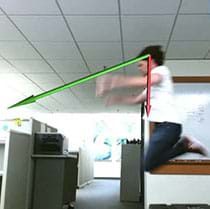

User Comments & Tips